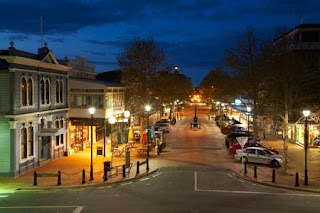The main road running East-West through central Vancouver is called ‘Broadway’. When you drive along it, the names of the streets which cut across it are hung above the road. Driving East after Alma Street, you cross over Collingwood Street and Waterloo Street, Blenheim Street and Balaclava Street, and then Trafalgar Street. Names of the battles and heroes of the British Empire in the 19th Century are found all over Canada, Australia and New Zealand, together of course with streets, parks, gardens, cities and towns and one Australian state named after Queen Victoria herself. They are part of the cultural heritage of Britain, as much as the English language, the rule of law, representative government, fish and chips, and the kilt and the bagpipes.
As British people settled in different lands, they adapted this heritage to take account of the native people and settlers from other countries, the strange new landscape they found themselves in, and the very distance from the mother country. They innovated new ways of building, farming, and governing themselves, and also new ways of speaking English. The most extraordinary adaptation to the lives of the native peoples took place in Canada, where British and French settlers learnt from the First Nations how to survive, travel and trap fur in the vast boreal North of the country. Adaptation to the new landscape came more slowly. For several generations, British settlers tried to make their new land resemble the old - importing plants, animals and pests, and creating gardens of rose bushes and herbaceous borders. Eventually, their descendents came to love and feel at home in the bush, and venerate indigenous trees and animals and national symbols. Their farmers adapted to the opportunities of a warmer climate, and in New Zealand and Australia developed the best wines in the world.
To a visitor like myself, the most striking signs of innovation in Canada, Australia and New Zealand are the towns and the buildings. In all three countries, the smallest communities have very wide streets, often set out in grid. Many have wooden buildings with elaborate facades, while, particularly in New Zealand, shops have ‘verandas’ (canopies over the street to protect the pedestrian from rain and the sun). These superb vernacular building styles are shown below, from Trafalgar Street in Nelson, New Zealand.
For comparison, there is a photograph, below, from the beautiful town of Nelson, British Columbia.
All of these countries settled from the British Isles have subsequently received people from many different lands. But the continuity with Britain remains strong. In 2003, my family visited Eastern Canada and one day came to Fredericton, the capital of the Province of New Brunswick. Fredericton was named after one of the sons of King George III, and was first settled by loyalists moving North after the American Rebellion. It is a small city, noted for its educational institutions and its support of the arts. There is a fine cathedral in English Gothic style facing a provincial parliament building, which, like most parliaments in the former British Empire is Gothic rather than Grecian or Roman in appearance. This is an outward display of the political theory that freedom is based on the continuity of the law rather than abstract reason. I asked to visit the provincial parliament building, and was surprised to find the Provincial Assembly in session. Speeches were bilingual, with each member switching easily between English and French. As I left, an august lady swept from her car to enter the building. She was the lieutenant governor, arriving to sign into law the bills that had just been voted by the assembly. I felt pleased and proud that such a civilised way of life, with its origins in the best British traditions, was maintained so well amidst a vast and beautiful wilderness of forests and mountains.


No comments:
Post a Comment
Comments welcome